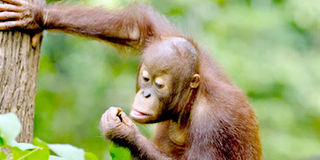Orangutan: world’s endangered ape

An Orangutan feeding in the forest, the only place it can be seen as one navigates by the Rongan River banks. NET PHOTO
If one is to talk about apes in Uganda, it would be a gorilla, chimpanzee or baboon. But many miles across the ocean in Indonesia is a species of apes called the Orangutan, an only member of the ape species on the Asian continent.
Like any other apes in the world, the Orangutan is guilty of habitat encroachment. It’s also a victim to poaching and pet trade, drastically reducing their numbers to near extinction.
Where they are found
At the Nyaru Menteng Rescue and Rehabilitation Centre in Indonesia, one of the few Orangutan rescue centres in Asia, it is not easy to spot the apes as one navigates the Rongan River banks.
They can only be seen when swinging on trees, fighting for food or somewhere hiding and observing visitors on passing boat. However, these are just a handful of about 625 Orangutans living at this centre in Palangka Raya, Indonesia’s Central Kalimantan province. The Orangutan have been gathered in the rescue centre because they are prone to attacks from people living in different areas.
In February last year, the Natural Resource Conservation Agency (BKSDA) of the Forestry Department in Indonesia, confiscated two-year-old Frengky (one of the orangutans) - from the area of Singkawang, on the north coast of West Kalimantan.
Within two months, another young orangutan, Thomas, was rescued from Sintang, also in the northern part of West Kalimantan province.
It wasn’t long before a third orangutan, Caleb, was confiscated - this time in Ketapang, a small town in the southern part of the province. Others like Himba and Cheetah were rescued a few years back from human attacks including burning.
These occurrences are common because in the recent decades, the populations on both islands have decreased dramatically in size, as a result of legal and illegal logging, conversion of forests for palm oil estates, fires leading to the illegal killing and capture of the wild beings, Anton Nurcahyo programme manager of the rehabilitation centre says.
Despite many interventions to conserve Orangutans, Nurcahyo, says the cases of battered and traded Orangutans have not declined. For this reason, the centre has been filled to capacity with it shouldering more than 230 Orangutans beyond capacity.
“We have to give food and fruits to the orangutans whenever it is not fruiting season. But at times the food is not enough. We are supposed to accommodate 400 Orangutans but now we have 625 and they must compete for the space and food,” Mr Nurcahyo says adding.
Fear of extinction
“Despite their dire need for food, the community does not view the animals in good faith because by the time we get them, some of the Orangutans are ill. So we usually give them medicine. But this has led to hostility from the community who feel they are more entitled to the medicines than the apes.”
Although there have not been any cases of the apes invading nearby gardens, Mr Nurcahyo fears that should they stray, the results would be nasty. So this has stopped the authorities at the centre to release the apes back to the jungle due to lack of a suitable habitat.
There is no road link between this area and West Kalimantan - nor is there a direct air link - so the orangutans would have to be flown via Jakarta within a day whenever they are rescued.
Species
There are two species of orangutans, the Sumatran orangutan (Pongo abelii) distributed over Sumatera Island and the Borneaen orangutan (Pongo pygmaeus) distributed in Kalimantan Island (Borneo).
The other three species of great apes can be found in Africa: chimpanzee (Pan troglodytes), the gorilla and the Bonobo (Pan paniscus). The habitat of orangutan is lowland tropical forest, swamped forest or hill forests in the height of 1,500m above sea level.
Currently, they inhabit remaining forests in Kalimantan and Sumatera (90 per cent), while the rest are found in the Malaysian remaining forests (Sabah and Serawak); Orangutans are arboreal creatures, which nest above high trees and spend more daily activities above the ground, eating fruits (frugivore).
They also eat leaves, flowers, and cambium. Termites and ants are part of their diet to obtain protein. For minerals, orangutans sometimes eat soil. The most recent published estimates by PanEco Foundation – Sumatran Orangutan Conservation Programme, indicate that only around 6,600 wild Sumatra orangutans and around 54,000 Bornean orangutans remain in the world.
International Union for Conservation of Nature and Natural Resources (IUCN) put orangutans in the category of Critically Endangered animals in the world and estimated that in one or two decades, orangutans will face extinction.
For now, the Orangutan Tropical Peatland Project is working to protect one of the Sabangau Forest in Central Kalimantan where the behavioral ecology of the flagship ape species- Orangutan lives and work with local partners to develop conservation solutions.




